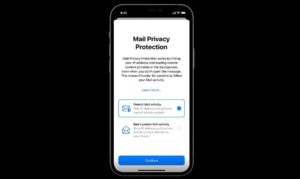Earlier this year Apple brought in changes to Facebook tracking for iOS users, which have already caused a noticeable impact on many of our charity partner’s Facebook Ads campaigns. We covered those changes on our blog, along with what actions charities needed to take to prepare. With Apple releasing more changes, this time on mail privacy for iOS users, we’ve put together another guide on the latest changes, and what charities should do as a result.
What are the changes?
Apple have announced Mail Privacy Protection for their Mail app, set to launch this year between September and November. Apple Mail users will be given a choice between two options: protect mail activity and don’t protect mail activity. Faced with this choice, we think it’s safe to assume most people will choose to be protected (only 12% of users opted in to ad-tracking when Apple gave them the choice earlier this year).

For the presumed majority who choose to be protected, Apple Mail’s server will now open all of their emails, and store the content, including the tracking pixel (the tiny image on every email that’s used to track opens). So most email recipients will register as having opened your email, whether or not they’ve actually opened it themselves. The bad news: you’ll no longer be able to track whether supporters using Apple iOS have actually opened an email you’ve sent.
The bottom line is….click rate will remain unaffected, but open rate will no longer be reliable.
This won’t be a sudden change. We know Apple is bringing this in during the autumn, but it’s likely to happen incrementally, and even once Apple rolls it out, it’ll rely on people updating their phones. We’re likely to see a gradual increase in Apple Mail open rates over the coming months, with the full impact becoming clearer in early 2022. Litmus expects around 50% of contacts on the average email list to be affected by this change, so it’s likely to impact you. They also have an excellent article with the nuts and bolts details of the change here.
What do the changes mean?
This will affect us all
Email plays a vital role in digital mobilisation. It’s still the number one channel for communicating with your supporters at scale to encourage meaningful actions – from donations to campaign actions and more. You’re likely using open rate in some shape or form as part of your email work. Common uses of it are: segmenting your audience (including in automations), list hygiene, subject line testing and reporting. We suggest you first take stock and consider everywhere that you’re currently using open rate.
What do charities need to do?
1. First things first: stop measuring performance using open rate
Once the changes come in, open rate is going to become unreliable, so we should all start getting used to the idea that it’s a metric to move away from. It’s time we start changing the way we report on, segment and operate our email programmes.
Others around you may be less keen to move away from a trusted metric that’s been a reassuring and reliable companion since email marketing began. Start sowing the seeds. Make sure your colleagues, managers, directors and trustees are aware of the change, and what it means for your future email reporting.
2. Next, it’s goodbye open rate; hello click rate!
We’d strongly suggest replacing open rate with click rate as a way of measuring the success of your emails. That means looking at click rate per recipient (rather than click to open rate) as the main metric of email success.
This is, in fact, a positive: click rate is already the best measure of who’s engaged in your email programme, as it shows who’s taking action – whether that’s donating, signing petitions, writing to MPs, sharing content on social media, participating in polls, downloading reports or buying from your online shop. So being forced to focus on that metric should lead to more engaging emails.
A concrete step you can take to facilitate this is, if you haven’t already, look at historical email data from the last year and set benchmarks for click rate for different types of emails. This will set up your click reporting, and really emphasise future performance.
3. Give supporters opportunities to click
Now you’re focusing on click rate, you’ll also want to make sure you’re maximising the number of clicks you’re getting on your emails. More clicks on your emails = measurable engagement in your work, so with that in mind you should:
- Prioritise sending emails with a single call to action. Too much choice is known to reduce action rates.
- Include a whole range of asks in your emails, not just donation asks. Some of our favourites are polls, surveys, petitions/handraisers, download report or other freebie and follow on social media. Including a variety of asks regularly means you’ll increase the percentage of your list who are clicking.
- Make the action as clear as possible: use bright, bold buttons with compelling copy.
- Move away from newsletters towards action-focused emails. Newsletter style emails don’t generally have a clear call to action, and so you may struggle with generating good results and reporting on them once the changes come in.
4. Work on your list hygiene
In the past, open rate has served us well in helping us keep on top of list hygiene. This is important for deliverability (having good delivery rates), and keeping costs down, especially if you’re paying for your CRM by number of contacts. While you can continue using open rate to define who’s ‘active’ in the short term, the more time that passes, the more cluttered your list is going to get with people who are wrongly marked as active because of this new change.
Over time, it’ll be important to change how you measure list health. We suggest you redefine an ‘active’ user as anyone who has either signed up to your email list in X months (we suggest 12), OR who has clicked, donated, signed a petition or taken another action. This will be a far smaller number of people than if you used open rate, but it will represent the section of your list that is genuinely active.
5. Test your subject lines
A/B testing subject lines is a basic but important tactic for improving your email programme performance. At the moment, when we test subject lines we look to see if there is a statistically significant difference in click rate between the variants, and if there isn’t, we then look at open rates.
For emails where there is a higher click rate (such as petitions) it’s more likely we’d be able to see a difference in click rate between variants. For emails where there is a lower click rate (because of a higher bar ask, like a fundraising email) then we wouldn’t be able to detect a significant difference in click rate between variants and we’d tend to use open rate to decide which subject line to send to the full list.
However, with these changes rendering open rates unreliable, you’ll only be able to use click rate to determine the winner of subject line tests, which will in turn mean that you’ll need to have fewer variants in a subject line test and use larger sample sizes to try and increase the likelihood of getting a significant result. This is particularly true of higher bar emails where the click rate is lower, like fundraising emails.
Now would also be a good time to review existing data and subject line tests you’ve already run to see if there are any patterns in terms of which types or format of subject line are consistently working for you. But remember to make sure you’re using a statistical significance calculator to work out if differences are statistically significant or not.
6. Change how you use segmentation and automations
You may currently use open rate as a way to decide who gets sent certain emails. For example, you may send reminders to anyone who hasn’t opened the previous email. That will no longer be possible.
Instead, we recommend using click-rate or action-rate as a way of segmenting. You’ll still be able to send a donation email to anyone who hasn’t clicked on the previous one, or who hasn’t donated.
In the long term it’s possible that an email provider like Mailchimp will allow you to send subject line tests to non-Apple Mail users which would mean that once again we’d be able to use open rate as a way of running rapid subject line testing. But we’re not banking on it: instead, we’re focused on taking the actions we’ve outlined above to make sure our partners – and their email programmes – are ready for this change.
NB: The current functionality on platforms like Mailchimp that allows you to segment by email client isn’t sufficient to get around these upcoming changes – there is currently no way of knowing who is accessing their email account through Apple Mail vs Android or other providers (for example, you could have a Gmail account and alternate between accessing it through your browser and through Apple Mail on your desktop).
Summary
Ultimately, this change presents an opportunity to run better email programmes.
The upcoming change has similarities to the pre-GDPR fear we collectively experienced as a sector back in 2018, although maybe not on the same scale. While it’s yet to be seen exactly how this will affect us and our email programmes, we suspect that, like GDPR, it may be a slightly uncomfortable period of change, before coming out of the other side in a better place. This is a chance to re-focus our attention on more meaningful metrics, and to cultivate smaller, more engaged email lists.
We’ll keep this blog updated with any new information or changes to the advice that comes up. In the meantime, feel free to get in touch with us on Twitter or via hello@forwardaction.uk if you have any questions or need help.


